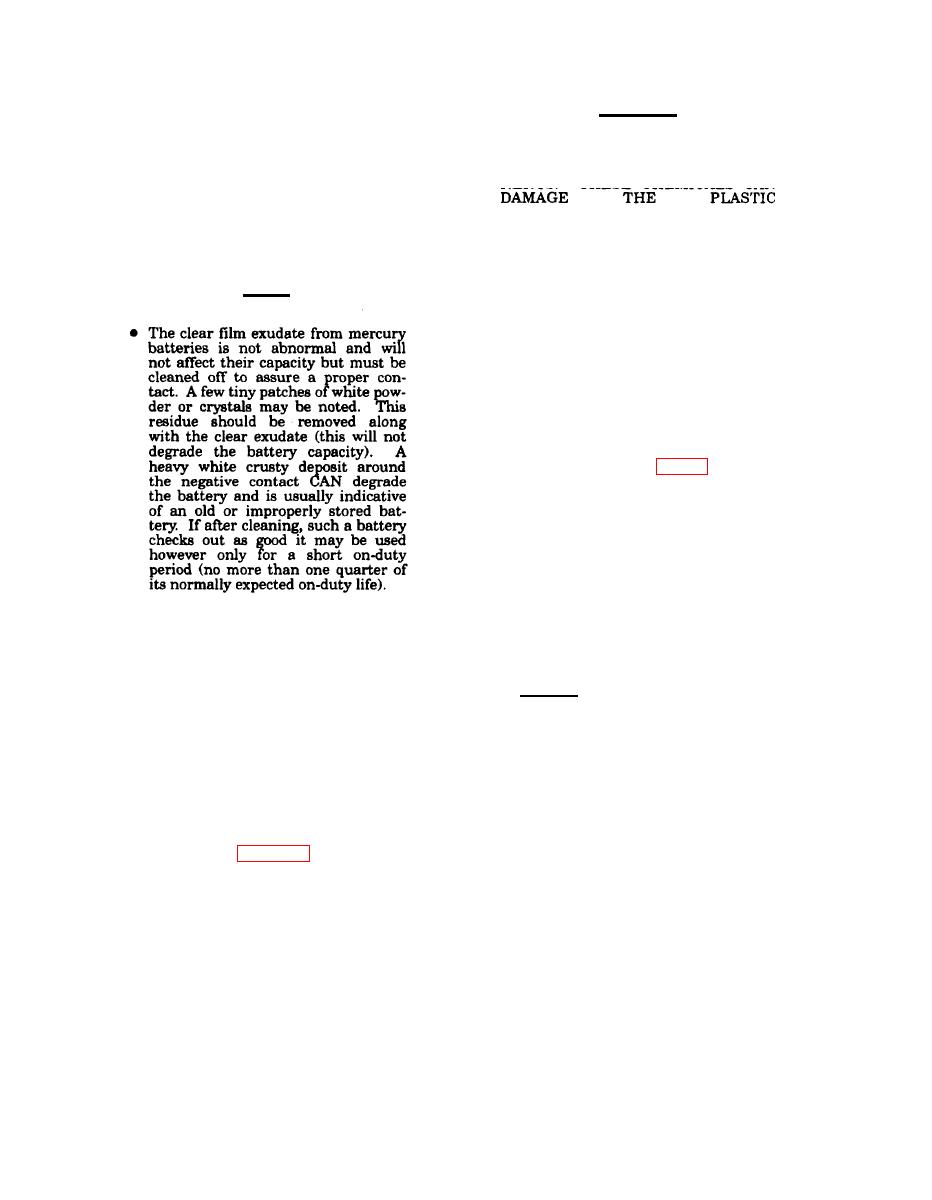 |
|||
|
|
|||
|
Page Title:
CLEANING BATTERIES AND CONTACTS |
|
||
| ||||||||||
|
|
 TM 9-1375-213-12-3
TO 11A20-15-1
CAUTION
3-4.
CLEANING BATTERIES AND
CONTACTS
DO NOT USE ELECTRICAL CON-
TACT CLEANER ON THE BATTERY
a. Before installing a receiver battery, wipe
CONTACTS OF M122 COMPO-
both of its contacts with a clean cloth. Ifa mer-
NENTS. THESE CHEMICALS CAN
c u r ybattery is being used rub both contacts
with clean pencil eraser and then again wipe
COMPONENTS.
with a clean rag. This will remove any film exu-
date that may have developed in storage.
b. Battery contacts on both M122 compo-
nents and the receiver batteries should be
NOTE
inspected and, if necessary wiped with a clean
dry rag or a cotton tipped swab (Q-tip or equiva-
lent) when a battery is removed. Wipe the used
receiver battery to determine if it leaked and
therefore extra attention should be given to the
receiver's battery contacts. If more than a dry
rag is required to clean the battery's contacts,
use an alcohol dampened rag or swab.
c. To clean the transmitter's battery pack
connector, reach all the way into the battery
compartment with a rag (fig. 3-1). The connec-
tor is at the top center oft e battery compart-
ment.
d. To clean a transmitter battery pack's con-
nector, use a toothpick or similar small probe to
scrape the inside of the metal tube within each
hole of the battery's connector.
e, To clean a receiver's internal battery con-
tact, if necessary use a cleaning rag wrapped
A n y alkaline battery found with
q
around a small twig.
ANY LIQUID or a HEAVY crusty or
crystal exudate should not be used.
WHEN TO REPLACE BATTERIES
3-5.
Any alkaline attery showing ANY
EXUDATE should not be used at
a. Receiver. Expected on-duty service life
high (above +80F) temperatures.
for the two types of batteries usable in the
At moderate or low temperatures an'
receiver are given in the tabulated data of para-
alkaline battery with a small amount
of nonliquid exudate ma be cleaned
graph 1-11. The service life applies to fresh bat-
and used for up to half of its nor-
teries. In continuous functioning se (such as
on a demolition range), each using unit will get
mally expected on-duty life. Elec-
tronics/supplies issue units which
a different service life depending upon number
issue
batteries are
of caps fired, onduty times, battery age, and
normally
equipped with a battery test instru-
the temperatures to which the batteries are sub-
jetted. If batteries ae being kept on hand for
ment and can check batteries when-
ever there is a question of their
an extended period, assure they do not exceed
their she life. Nominal shelf life for the
usability (see para 3-10).
receiver battery types in unrefrigerated moder-
ate temperature storage is as follows:
3-2
|
|
Privacy Statement - Press Release - Copyright Information. - Contact Us |